ASUS P5A User Manual







 R P5A
R P5A
Pentium® Super7 Motherboard
USER’S MANUAL

USER'S NOTICE
No part of this manual, including the products and software described in it, may be reproduced, transmitted, transcribed, stored in a retrieval system, or translated into any language in any form or by any means, except documentation kept by the purchaser for backup purposes, without the express written permission of ASUSTeK COMPUTER INC. (“ASUS”).
ASUS PROVIDES THIS MANUAL “AS IS” WITHOUT WARRANTY OF ANY KIND, EITHER EXPRESS OR IMPLIED, INCLUDING BUT NOT LIMITED TO THE IMPLIED WARRANTIES OR CONDITIONS OF MERCHANTABILITY OR FITNESS FOR A PARTICULAR PURPOSE. IN NO EVENT SHALL ASUS, ITS DIRECTORS, OFFICERS, EMPLOYEES OR AGENTS BE LIABLE FOR ANY INDIRECT, SPECIAL, INCIDENTAL, OR CONSEQUENTIAL DAMAGES (INCLUDING DAMAGES FOR LOSS OF PROFITS, LOSS OF BUSINESS, LOSS OF USE OR DATA, INTERRUPTION OF BUSINESS AND THE LIKE), EVEN IF ASUS HAc BEEN ADVISED OF THE POSSIBILITY OF SUCH DAMAGES ARISING FROM ANY DEFECT OR ERROR IN THIS MANUAL OR PRODUCT.
Product warranty or service will not be extended if: (1) the product is repaired, modified or altered, unless such repair, modification of alteration is authorized in writing by ASUS; or (2) the serial number of the product is defaced or missing.
Products and corporate names appearing in this manual may or may not be registered trademarks or copyrights of their respective companies, and are used only for identification or explanation and to the owners’ benefit, without intent to infringe.
•ALi and Aladdin are trademarks of Acer Laboratories Inc. (ALi)
•Adobe and Acrobat are registered trademarks of Adobe Systems Incorporated.
•AMD, K6, Super7, and combinations thereof are trademarks of Advanced Micro Devices, Inc.
•Cyrix, M II, and combinations thereof are trademarks of National Semiconductor Corporation.
•ESS, Maestro, Solo-1 are registered trademarks of ESS Technology, Inc.
•IBM is a registered trademark of IBM Corporation.
•IDT and WinChip are trademarks of Integrated Device Technology, Inc.
•Intel, LANDesk, and Pentium are registered trademarks of Intel Corporation.
•Symbios is a registered trademark of Symbios Logic Coråporation.
•Windows and MS-DOS are registered trademarks of Microsoft Corporation.
The product name and revision number are both printed on the product itself. Manual revisions are released for each product design represented by the digit before and after the period of the manual revision number. Manual updates are represented by the third digit in the manual revision number.
For previous or updated manuals, BIOS, drivers, or product release information, contact ASUS at http://www.asus.com.tw or through any of the means indicated on the following page.
SPECIFICATIONS AND INFORMATION CONTAINED IN THIS MANUAL ARE FURNISHED FOR INFORMATIONAL USE ONLY, AND ARE SUBJECT TO CHANGE AT ANY TIME WITHOUT NOTICE, AND SHOULD NOT BE CONSTRUED AS A COMMITMENT BY ASUS. ASUS ASSUMES NO RESPONSIBILITY OR LIABILITY FOR ANY ERRORS OR INACCURACIES THAT MAYAPPEAR IN THIS MANUAL, INCLUDING THE PRODUCTS AND SOFTWARE DESCRIBED IN IT.
Copyright © 1999 ASUSTeK COMPUTER INC. All Rights Reserved.
Product Name: |
ASUS P5A |
Manual Revision: |
1.07 E382 |
Release Date: |
May 1999 |
|
|
2 |
ASUS P5A User’s Manual |

ASUS CONTACT INFORMATION
ASUSTeK COMPUTER INC. (Asia-Pacific)
Marketing
Address: |
150 Li-Te Road, Peitou, Taipei, Taiwan 112 |
Telephone: |
+886-2-2894-3447 |
Fax: |
+886-2-2894-3449 |
Email: |
info@asus.com.tw |
Technical Support
Tel (English): |
+886-2-2894-3447 |
ext. 706 |
Tel (Chinese): |
+886-2-2894-3447 |
ext. 111 |
Fax: |
+886-2-2895-9254 |
|
Email: |
tsd@asus.com.tw |
|
Newsgroup: |
news2.asus.com.tw |
|
WWW:www.asus.com.tw
FTP: ftp.asus.com.tw/pub/ASUS
ASUS COMPUTER INTERNATIONAL (America)
Marketing
Address: |
6737 Mowry Avenue, Mowry Business Center, Building 2 |
|
Newark, CA 94560, USA |
Fax: |
+1-510-608-4555 |
Email: |
info-usa@asus.com.tw |
Technical Support
Fax: +1-510-608-4555
BBS: +1-510-739-3774
Email: tsd-usa@asus.com.tw
WWW:www.asus.com
FTP: ftp.asus.com.tw/pub/ASUS
ASUS COMPUTER GmbH (Europe)
Marketing
Address: |
Harkort Str. 25, 40880 Ratingen, BRD, Germany |
Telephone: |
49-2102-445011 |
Fax: |
49-2102-442066 |
Email: |
sales@asuscom.de |
Technical Support
Hotline: 49-2102-499712
BBS: 49-2102-448690
Email: tsd@asuscom.de
WWW:www.asuscom.de
FTP: ftp.asuscom.de/pub/ASUSCOM
ASUS P5A User’s Manual |
3 |

CONTENTS
I. INTRODUCTION ........................................................................... |
7 |
How this Manual is Organized ........................................................ |
7 |
Item Checklist .................................................................................. |
7 |
II. FEATURES .................................................................................... |
8 |
ASUS P5A Motherboard ................................................................. |
8 |
Introduction to ASUS Smart Series Motherboards .............. |
9 |
Parts of the ASUS P5A Motherboard .............................................. |
11 |
III. INSTALLATION .......................................................................... |
12 |
ASUS P5A Motherboard Layout ..................................................... |
12 |
Installation Steps .............................................................................. |
14 |
1. Jumpers ........................................................................................ |
14 |
Jumper Settings .................................................................... |
14 |
Compatible Cyrix CPU Identification .................................. |
18 |
2. System Memory (DIMM) ............................................................ |
19 |
DIMM Memory Installation Procedures: ............................. |
20 |
3. Central Processing Unit (CPU) ................................................... |
21 |
4. Expansion Cards ......................................................................... |
23 |
Expansion Card Installation Procedure: ............................... |
23 |
Assigning IRQs for Expansion Cards ................................... |
23 |
Assigning DMA Channels for ISA Cards ............................. |
24 |
ISA Cards and Hardware Monitor ........................................ |
24 |
Accelerated Graphics Port .................................................... |
24 |
5. External Connectors .................................................................... |
25 |
Power Connection Procedures ................................................... |
35 |
Support Software ............................................................................. |
36 |
Flash Memory Writer Utility ...................................................... |
36 |
IV. BIOS SOFTWARE ....................................................................... |
36 |
Main Menu ........................................................................... |
36 |
Managing and Updating Your Motherboard’s BIOS .................. |
38 |
6. BIOS Setup ................................................................................. |
39 |
Load Defaults ....................................................................... |
40 |
Standard CMOS Setup ............................................................... |
40 |
Details of Standard CMOS Setup ......................................... |
40 |
BIOS Features Setup .................................................................. |
43 |
Details of BIOS Features Setup ............................................ |
43 |
Chipset Features Setup ............................................................... |
45 |
Details of Chipset Features Setup ......................................... |
46 |
Power Management Setup .......................................................... |
49 |
Details of Power Management Setup ................................... |
49 |
4 |
ASUS P5A User’s Manual |

CONTENTS
PNP and PCI Setup .................................................................... |
52 |
Details of PNP and PCI Setup .............................................. |
52 |
Load BIOS Defaults ................................................................... |
54 |
Load Setup Defaults ................................................................... |
54 |
Supervisor Password and User Password .................................. |
55 |
IDE HDD Auto Detection .......................................................... |
56 |
Save & Exit Setup ...................................................................... |
57 |
Exit Without Saving ................................................................... |
57 |
V. SUPPORT SOFTWARE ................................................................ |
59 |
ASUS Smart Motherboard Support CD ........................................... |
59 |
Desktop Management Interface (DMI) ............................................ |
60 |
Introducing the ASUS DMI Configuration Utility ............... |
60 |
System Requirements ........................................................... |
60 |
Using the ASUS DMI Configuration Utility ........................ |
61 |
VI. ASUS CIDB ................................................................................... |
63 |
The ASUS CIDB Chassis Sensor ............................................... |
63 |
Using the ASUS CIDB ......................................................... |
63 |
Setting up the ASUS CIDB .................................................. |
64 |
ASUS CIDB Additional Considerations .............................. |
64 |
VII. ASUS LAN Card ......................................................................... |
65 |
ASUS PCI-L101 Fast Ethernet Card ............................................... |
65 |
Features ............................................................................................ |
66 |
Software Driver Support ............................................................ |
66 |
Question and Answer ................................................................. |
66 |
APPENDIX .......................................................................................... |
67 |
Glossary ........................................................................................... |
67 |
ASUS P5A User’s Manual |
5 |

FCC & DOC COMPLIANCE
Federal Communications Commission Statement
This device complies with FCC Rules Part 15. Operation is subject to the following two conditions:
•This device may not cause harmful interference, and
•This device must accept any interference received, including interference that may cause undesired operation.
This equipment has been tested and found to comply with the limits for a Class B digital device, pursuant to Part 15 of the FCC Rules. These limits are designed to provide reasonable protection against harmful interference in a residential installation. This equipment generates, uses and can radiate radio frequency energy and, if not installed and used in accordance with manufacturer’s instructions, may cause harmful interference to radio communications. However, there is no guarantee that interference will not occur in a particular installation. If this equipment does cause harmful interference to radio or television reception, which can be determined by turning the equipment off and on, the user is encouraged to try to correct the interference by one or more of the following measures:
•Re-orient or relocate the receiving antenna.
•Increase the separation between the equipment and receiver.
•Connect the equipment to an outlet on a circuit different from that to which the receiver is connected.
•Consult the dealer or an experienced radio/TV technician for help.
WARNING! Any changes or modifications to this product not expressly approved by the manufacturer could void any assurances of safety or performance and could result in violation of Part 15 of the FCC Rules.
Canadian Department of Communications Statement
This digital apparatus does not exceed the Class B limits for radio noise emissions from digital apparatus set out in the Radio Interference Regulations of the Canadian Department of Communications.
This Class B digital apparatus complies with Canadian ICES-003.
Cet appareil numérique de la classe B est conforme à la norme NMB-003 du Canada.
6 |
ASUS P5A User’s Manual |

I. INTRODUCTION
How this Manual is Organized
I.Introduction Manual information and checklist
II. |
Features |
Information and specifications concerning this product |
III. |
Installation |
Instructions on setting up the motherboard |
IV. |
BIOS Software |
Instructions on setting up the BIOS software |
V.Support Software Information on the included support software
VI. ASUS CIDB |
Installation of the ASUS CIDB Chassis Sensor (optional) |
VII. ASUS L101 Card |
Installation of the ASUS LAN card (optional) |
APPENDIX |
Glossary of Terms |
Item Checklist
Please check that your package is complete. If you discover damaged or missing items, contact your retailer.
(1) ASUS Motherboard
(1) IDE ribbon cable for master and slave drives
(1) Ribbon cable for (1) 5.25” and (2) 3.5” floppy disk drives
(1) Bag of spare jumpers
(1) Support CD with drivers and utilities
(1) User’s Manual
ASUS CIDB chassis sensor module (optional)
ASUS IrDA-compliant infrared module (optional)
ASUS PCI-L101 Wake-On-LAN 10/100 Ethernet Card (optional)
I. INTRODUCTION |
Sections/Checklist |
|
|
ASUS P5A User’s Manual |
7 |

TURES FEA .II
Features
II. FEATURES
ASUS P5A Motherboard
•ALi AGPset: ALi® (Acer Laboratories Inc.) Aladdin V AGPset with support for a 100MHz Front Side Bus (FSB), Accelerated Graphics Port (AGP), and all current Socket 7 processors.
•Multi-Processor/Multi-Speed Support: AMD K6™ -III/400 & faster, AMD K6™ - 2/266 & faster, AMD K6™ /166 & faster, AMDK5™ /90–133, IBM® /Cyrix® 6x86MX™ /
M II™ (PR166 & faster), IDT WinChip 2™ /240 & faster, IBM® /Cyrix® 6x86-PR166+ (Rev 2.7 or later), Intel Pentium® 90–233MHz (P55C-MMX™ , P54C/P54CS).
•Level 2 Cache SRAM/Tag RAM: Features 512KB/1MB pipelined-burst SRAM/L2 memory cache and integrated Tag RAM to make using the 100MHz bus speed possible.
•Enhanced ACPI and Anti-Boot Virus BIOS: Features a programmable BIOS, offering enhanced ACPI for Windows 98 compatibility, built-in hardware-based virus protection through Trend ChipAwayVirus, and autodetection of most devices for virtually automatic setup.
•PC100 Memory Support: Equipped with three DIMM sockets to support Intel PC100compliant SDRAMs (8, 16, 32, 64, 128, or 256MB) up to 768MB. These new SDRAMs are necessary to meet the enhanced 95MHz/100MHz bus speed requirement.
•AGP Slot: Supports AGP cards for high performance, component level interconnection targeted at 3D graphical display applications.
•PCI Audio (optional): Features ESS 32-bit PCI audio onboard.
•Ultra DMA/33 BM IDE: Comes with an onboard PCI Bus Master IDE controller with two connectors that supports four IDE devices in two channels, supports Ultra DMA/33, PIO Modes 3 and 4 and Bus Master IDE DMA Mode 2, and supports Enhanced IDE devices, such as Tape Backup and CD-ROM drives. Supports two drives of either 5.25-inch (360KB or 1.2MB) or 3.5-inch (720KB, 1.44MB, or 2.88MB) disk drives. Supports Japanese “Floppy 3 mode” (3.5-inch disk drive: 1.2MB) and LS-120 floppy disk drives (3.5-inch disk drive: 120 MB, 1.44MB, 720K). BIOS supports IDE CD-ROM or SCSI device boot-up.
•Wake-On-LAN Connector: Supports Wake-On–LAN activity with special network cards, such as the ASUS PCI-L101 10/100 Fast Ethernet PCI card.
•PC Health Monitoring (optional): Provides a convenient utility to monitor your system’s vital components/activities, such as fan rotations, voltages, and temperatures.
•Super Multi-I/O: Provides two high-speed UART compatible serial ports and one parallel port with EPP and ECP capabilities. UART2 can also be directed from COM2 to the Infrared Module for wireless connections.
•Desktop Management Interface (DMI): Supports DMI through BIOS, which allows hardware to communicate within a standard protocol creating a higher level of compatibility. (Requires DMI-enabled components.) (See section V)
•USB, PS/2 Mouse, IrDA Connector: Supports an optional cable and bracket set to mount the connectors to an unused expansion slot on the system chassis. A second IrDA connector is available for a standard individual infrared cable set.
8 |
ASUS P5A User’s Manual |

II. FEATURES
Introduction to ASUS Smart Series Motherboards
Performance
•SDRAM Optimized Performance:ASUS Smart Series motherboards support the new generation memory—Synchronous Dynamic Random Access Memory (SDRAM)—which increases the data transfer rate to 800MB/sec max using PC100-compliant SDRAM.
•Double the IDE Transfer Speed:ASUS Smart Series motherboards with ALi’s Aladdin V chipset improves IDE transfer rate using UltraDMA/33 Bus Master IDE, which can handle data transfer up to 33MB/sec. The best of all is that this new technology is compatible with existing ATA-2 IDE specifications so there is no need to upgrade current hard drives or cables.
•Concurrent PCI: Concurrent PCI allows multiple PCI transfers from PCI master buses to memory to CPU.
•ACPI Ready:ACPI (Advanced Configuration and Power Interface) is also implemented on all ASUS Smart Series motherboards. ACPI provides more Energy Saving Features for the future operating systems (OS) supporting OS Direct Power Management (OSPM) functionality. With these features implemented in the OS, PCs can be ready around the clock, yet satisfy all the energy saving standards. To fully utilize the benefits of ACPI, an OS that supports ACPI, such as Windows 98, must be used.
•PC’98 Compliant: Both the BIOS and hardware levels of the ASUS Smart Series motherboards meet PC’98 compliancy. The new PC’98 requirements for systems and components are based on the following high-level goals: Support for Plug and Play compatibility and power management for configuring and managing all system components, and 32-bit device drivers and installation procedures for Windows 95/Windows 98 and Windows NT.
Intelligence (with optional Hardware Monitor only)
•Fan Status Monitoring and Alarm: To prevent system overheat and system damage, the CPU fan and system fans are monitored for RPM and failure. Each fan can be set for its normal RPM range and alarm thresholds.
•Temperature Monitoring and Alert: To prevent system overheat and system damage, there is a heat sensor under the CPU and on the motherboard itself to monitor CPU and system temperature to make sure the system is operating at a safe heat level to avoid any failures triggered by extremely high temperature.
•Chassis intrusion Detection: Supports chassis-intrusion monitoring through LDCM and the optional ASUS CIDB chassis sensor module.
Smart Series
II. FEA TURES
ASUS P5A User’s Manual |
9 |

Smart |
FEA .II |
Series |
TURES |
|
|
II.FEATURES
•Voltage Monitoring and Alert: System voltage levels are monitored to ensure stable current to critical motherboard components. Voltage specifications are more critical for future processors, so monitoring is necessary to ensure proper system configuration and management.
•System Resources Alert:Today’s operating systems, such as Windows 95, Windows NT, and OS/2, require much more memory and hard drive space to present enormous user interfaces and run large applications. The system resource monitor will warn the user before the system resources are used up to prevent possible application crashes. Suggestions will give the user information on managing their limited resources more efficiently.
•CPU Slow Down:When CPU fans or system fans malfunction, the system will deactivate the CPU Clock line to decrease CPU utilization to the speed upon detection of system overheat. This will prevent CPU damage from system overheat. The CPU utilization will restore normal operations when temperature falls below a safe level.
•Auto Fan Off: The system fans will power off automatically even in sleep mode. This function reduces both energy consumption and system noise, and is an important feature in implementing silent PC systems.
•Dual Function Power Button (requires ATX power supply): The system can be in one of two states, one is Sleep mode and the other is Soft-Off mode. Pushing the power button for less than 4 seconds places the system into Sleep mode. When the power button is pressed for more than 4 seconds, it enters the Soft-Off mode.
•Remote Ring On (requires ATX power supply):This feature allows a computer to be turned on remotely through a modem. With this benefit on hand, any user can access vital information from their computer from anywhere in the world!
•Message LED (requires ACPI-supported OS): Chassis LEDs now act as information providers. Through the way a particular LED illuminates, the user can determine the stage the computer is in. A simple glimpse provides useful information to the user.
10 |
ASUS P5A User’s Manual |
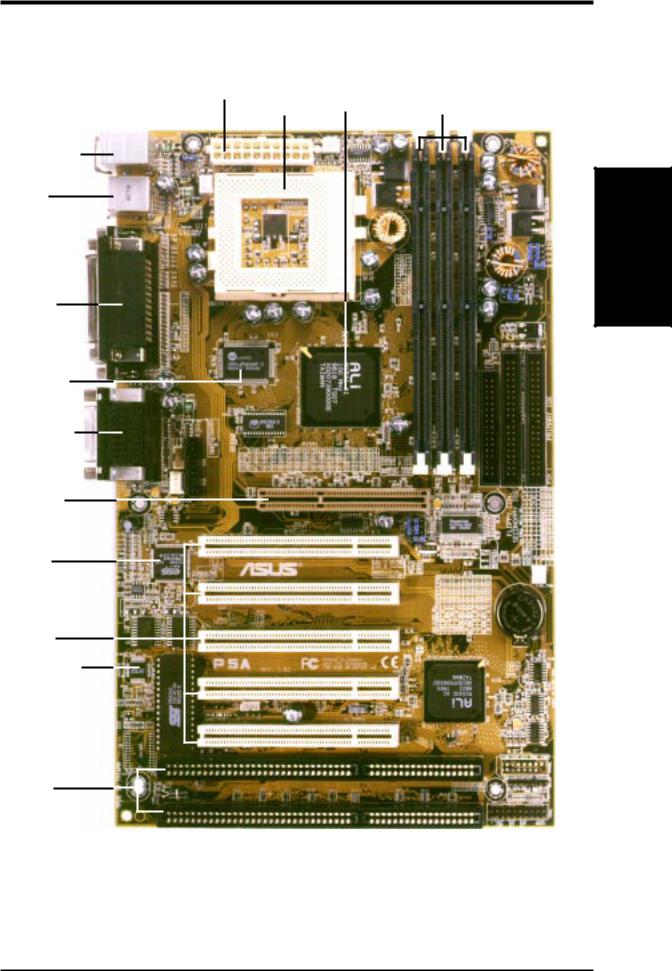
II. FEATURES
Parts of the ASUS P5A Motherboard
ATX Power CPU ZIF |
ALi Aladdin V |
3 DIMM |
Socket 7 |
AGPset |
Sockets |
PS/2 Mouse (top)
and Keyboard
USB Port
Serial and Parallel
Connectors
512KB/1MB Pipelined Burst L2 Cache
Game/MIDI Port (optional)
Accelerated
Graphics Port
ESS Audio (optional)
5 PCI Slots
Health Monitoring
Chip (optional)
2 ISA Slots
Motherboard Parts
II. FEA TURES
ASUS P5A User’s Manual |
11 |
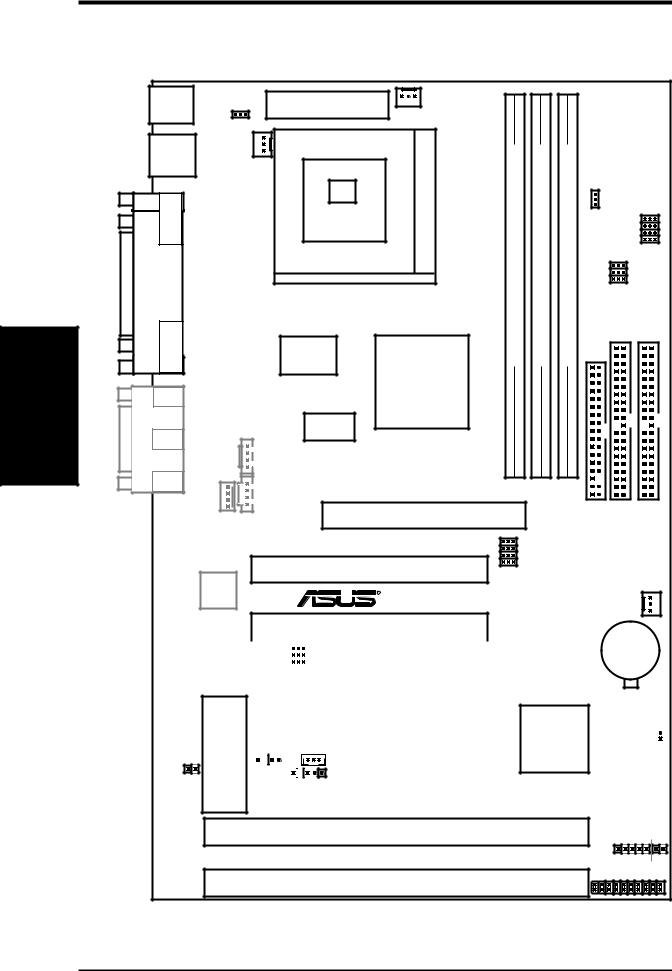
ALLATION INST .III
Layout Motherboard
III. INSTALLATION
ASUS P5A Motherboard Layout
|
PS2 |
Top: Mouse |
|
CPU_FAN |
|
|
|
|
|
|
|
Bottom: Keyboard |
Board Power Input |
|
|
|
|
|
|
||
|
|
|
|
|
|
|
|
|||
|
KBMS |
|
for ATX Power Supply |
|
|
|
|
|
|
|
|
|
KBPWR |
|
|
|
|
|
|
|
|
|
|
Top: USB 1 |
CPU ZIF Socket 7 |
|
|
|
|
|
|
|
|
USB |
Bottom: USB 2 |
module) |
module) |
module) |
VIO1 |
|
|
||
|
PWR_FAN |
|
|
|
|
|||||
|
|
|
|
|
|
|
|
|
||
ParallelPort |
2COM COM 1 |
|
|
1SocketDIMM(64-bit, 168-pin |
2SocketDIMM(64-bit, 168-pin |
3SocketDIMM(64-bit, 168-pin |
|
|
|
|
|
L2 Cache |
ALi |
|
|
|
|||||
|
|
|
CPU Thermal Sensor |
|
|
|
|
|
|
|
|
|
|
(Hardware Monitor) |
|
|
|
|
|
VID0 |
|
|
|
|
|
|
|
|
|
|
VID1 |
|
|
|
|
|
|
|
|
|
|
VID2 |
|
|
|
|
|
|
|
|
|
|
VID3 |
|
|
|
|
|
|
|
|
|
|
CPU Voltage |
|
|
|
|
|
|
|
|
|
BF2 |
|
|
|
|
|
|
|
|
|
|
BF1 |
|
|
|
|
|
|
|
|
|
|
BF0 |
|
|
|
|
|
|
|
|
|
|
Frequency Ratio |
|
|
|
|
|
512KB/1MB |
|
|
|
|
|
|
|
|
|
|
Pipelined Burst |
|
|
|
|
|
|
|
|
|
|
|
Aladdin V |
|
|
|
|
|
|
Port |
Line Out |
|
|
M1541 |
|
|
|
|
|
|
|
|
AGPset |
|
|
|
|
|
|
||
Game/Midi |
LineMic InIn |
|
|
|
|
|
|
|
|
|
|
Tag RAM |
|
|
|
|
|
|
|
||
|
|
|
|
|
|
|
|
|
|
|
|
|
CD1 |
|
|
|
|
|
|
|
|
|
|
|
|
Row |
0 1 |
2 3 |
4 5 |
|
|
|
|
|
AUX |
|
|
|
|
|
FloppyDrives |
SecondaryIDE |
PrimaryIDE |
|
|
Audio |
AGP Slot |
|
|
|
||||
|
|
Modem |
|
|
|
|
|
|
||
|
|
Connector |
|
|
|
|
|
|
|
|
|
|
|
|
|
FS0 |
|
|
|
|
|
|
|
|
|
|
FS1 |
|
|
|
|
|
|
|
|
|
|
FS2 |
|
|
|
|
|
|
|
PCI Slot 1 |
|
FS3 |
|
|
|
|
|
|
|
|
BUS Frequency |
|
|
|
|
||||
|
|
Chipset |
|
R |
|
|
|
|
|
|
|
|
(OPTIONAL) |
|
|
|
|
|
|
|
|
|
|
|
|
|
|
|
|
CHA_FAN |
|
|
PCI Slot 2
|
|
SGNT |
CR2032 |
|
|
3 Volt |
|
|
|
SREQ |
Lithium Cell |
|
|
SOLOID |
|
|
|
|
Hardware |
|
|
|
PCI Slot 3 |
|
|
|
||||||||||||||||
|
|
|
|
|
|
|
|
|
|
|
|
|
|
|
|
|
|
|
|
||||
Monitor |
Programmable EEPROMBIOS |
|
|
PCI Slot 5 |
|
ALi M1543C |
|
||||||||||||||||
|
|
|
|
|
|
|
|
||||||||||||||||
|
|
|
|
|
|
|
PCI Slot 4 |
|
Chipset |
CLRTC |
|||||||||||||
|
|
|
|
|
|
|
|
(IDE |
|
||||||||||||||
|
|
|
|
|
|
|
|
|
|
|
|
|
|
|
|
|
|
|
|
|
|
|
|
|
|
|
|
|
|
|
|
|
|
|
|
|
|
|
|
|
|
|
|
|
Wake-on-LAN Connector |
Controller) |
|
|
|
|
|
|
|
|
|
|
|
|
|
|
|
|
|
|
|
|
|
|
|
||
|
|
|
|
|
|
Chassis Int. |
|
|
|
|
|
|
|
|
|
|
SMBus Connector |
|
|
||||
|
|
|
|
|
|
|
|
|
|
|
|
|
|||||||||||
|
TRPWR |
|
Alarm Lead |
|
|
|
|
|
|
|
|
|
|
|
|
|
|||||||
|
|
|
|
|
|
|
|
|
|
|
|
|
|
|
|
|
|
|
|
|
|
|
|
ISA Slot 1
IR +
IDELED
Panel Connections
ISA Slot 2
Dimmed components are optional.
12 |
ASUS P5A User’s Manual |

III. INSTALLATION
Jumpers |
|
|
|
1) |
CLRTC |
p. 14 |
Real Time Clock (RTC) RAM |
2) |
KBPWR |
p. 15 |
Keyboard Power Up |
3) |
VIO1 |
p. 15 |
+3V Voltage Selection |
4) |
SGNT,SREQ,SOLOID |
p. 15 |
Audio Selection |
5) |
FS0, FS1, FS2, FS3 |
p. 16 |
CPU External (BUS) Frequency Selection |
6) |
BF0, BF1, BF2 |
p. 16 |
CPU to BUS Frequency Ratio |
7) |
VID0, VID1, VID2, VID3 |
p. 18 |
Voltage Regulator Output Selection |
Expansion Slots |
|
|
|
1) |
DIMM Sockets |
p. 19 |
168-Pin DIMM Memory Expansion Sockets |
2) |
CPU ZIF Socket 7 |
p. 21 |
Central Processing Unit (CPU) Socket |
3) |
SLOT 1, 2 |
p. 23 |
16-bit ISA Bus Expansion Slots* |
4) |
PCI 1, 2, 3,4,5 |
p. 23 |
32-bit PCI Bus Expansion Slots** |
Connectors |
|
|
|
1) |
PS2KBMS |
p. 25 |
PS/2 Keyboard Connector (6-pin Female) |
2) |
PS2KBMS |
p. 25 |
PS/2 Mouse Connector (6-pin Female) |
3) |
PARALLEL |
p. 26 |
Parallel (Printer) Port Connector (26-1 pins) |
4) |
COM1, COM2 |
p. 26 |
Serial Port COM1 & COM2 (10-1 pins) |
5) |
FLOPPY |
p. 26 |
Floppy Drive Connector (34-1 pins) |
6) |
GAME_AUDIO |
p. 27 |
Audio Port Connectors (Three 1/8” Female) |
7) |
GAME_AUDIO |
p. 27 |
Joystick/MidiConnector (15-pin Female) |
8) |
USB |
p. 27 |
Universal Serial BUS Ports 1 & 2 (Two 4-pin Female) |
9) |
PRIMARY/SECOND.IDE |
p. 28 |
Primary/Secondary IDE Connector (40-1 pins) |
10) |
IDELED |
p. 28 |
IDE LED Activity Light (2 pins) |
11) |
ATX |
p. 29 |
ATX Motherboard Power Connector (20 pins) |
12) |
CHASIS |
p. 29 |
Chassis Intrusion Alarm Lead (4-1 pins) |
13) |
FAN |
p. 30 |
Power Supply, Chassis, CPU Fan Power Leads (Three 3 pins) |
14) |
IR |
p. 30 |
IrDA-compliant Infrared Module Connector (5 pins) |
15) |
MSG.LED (PANEL) |
p. 31 |
System Message LED (2 pins) |
16) |
PWR SW. (PANEL) |
p. 31 |
ATX Power Switch/Soft Power Switch Lead (2 pins) |
17) |
RESET (PANEL) |
p. 31 |
Reset Switch Lead (2 pins) |
18) |
PWR.LED (PANEL) |
p. 31 |
System Power LED Lead (3 pins) |
19) |
KEYLOCK (PANEL) |
p. 31 |
Keyboard Lock Switch Lead (2 pins) |
20) |
SPEAKER (PANEL) |
p. 31 |
Speaker Output Connector (4 pins) |
21) |
WOLCON |
p. 32 |
Wake-on-LAN Activity Connector (3 pins) |
22) |
MODEM |
p. 32 |
MODEM Card Voice In Connector (4 pins) |
23) |
AUX |
p. 33 |
Stereo Audio In Connector (4 pins) |
24) |
CD1 |
p. 34 |
Stereo Audio In Connector (4 pins) |
25) |
SMB |
p. 34 |
SMBus Connector (5-1 pins) |
26) TRPWR |
p. 34 |
Power Supply Temperature External Connector (2 pins) |
|
*The onboard hardware monitor uses the address 290H-297H so legacy ISA cards must not use this address or else conflicts will occur.
**If the onboard audio (optional) is selected, PCI Slot 5 can only be used for a PCI slave device.
INST ALLATION |
Contents |
III. |
|
|
|
ASUS P5A User’s Manual |
13 |

ALLATION INST .III
Jumpers
III. INSTALLATION
Installation Steps
Before using your computer, you must complete the following steps:
1.Set Jumpers on the Motherboard
2.Install System Memory Modules
3.Install the Central Processing Unit (CPU)
4.Install Expansion Cards
5.Connect Ribbon Cables, Cabinet Wires, and Power Supply
6.Setup the BIOS Software
1. Jumpers
WARNING! Computer motherboards, baseboards and components, such as SCSI cards, contain very delicate Integrated Circuit (IC) chips. To protect them against damage from static electricity, you should follow some precautions whenever you work on your computer.
1.Unplug your computer when working on the inside.
2.Use a grounded wrist strap before handling computer components. If you do not have one, touch both of your hands to a safely grounded object or to a metal object, such as the power supply case.
3.Hold components by the edges and try not to touch the IC chips, leads or connectors, or other components.
4.Place components on a grounded antistatic pad or on the bag that came with the component whenever the components are separated from the system.
Jumper Settings
1.Real Time Clock (RTC) RAM (CLRTC)
The CMOS RAM is powered by the onboard button cell battery. To clear the RTC data: (1) Turn off your computer, (2) Short solder points using a small metalic object, (3) Turn on your computer, (4) Hold down <Delete> during bootup and enter BIOS setup to re-enter user preferences.
CLRTC
Short solder points to Clear CMOS
P5A Clear RTC RAM
14 |
ASUS P5A User’s Manual |

III.INSTALLATION
2.Keyboard Power Up (KBPWR)
This allows you to disable or enable the keyboard power up function. Set to Enable if you want to use your keyboard (by pressing <Spacebar>) to power up your computer.
1 |
1 |
2 |
2 |
3 |
3 |
Disable Enable
(DEFAULT)
|
|
|
|
|
|
|
|
|
|
|
|
|
|
|
|
|
|
|
|
|
|
|
|
|
|
|
|
|
This feature requires an ATX power supply that |
|
|
|
|
|
|
|
|
|
|
|
|
|
|
|
|
|
|
|
|
|
|
|
|
|
|
|
|
|
|
|
|
|
|
|
|
|
|
|
|
|
|
|
|
|
|
|
|
|
|
|
|
|
|
|
|
|
|
|
|
|
|
|
|
|
|
|
|
|
|
|
|
|
|
|
|
|
|
|
|
|
|
|
|
|
|
|
|
|
|
|
|
|
|
|
|
|
|
|
|
|
|
|
|
|
|
|
|
|
|
|
|
|
|
|
|
|
|
|
|
|
|
|
|
|
|
|
|
|
|
|
|
|
|
|
|
|
|
|
|
|
|
|
|
|
|
|
|
|
can supply at least 300mA on the +5VSB lead |
|
|
|
|
|
|
|
|
|
|
|
|
|
|
|
|
|
|
|
|
|
|
|
|
|
|
|
|
|
|
|
|
|
|
|
|
|
|
|
|
|
|
|
|
|
|
|
|
|
|
|
|
|
|
|
|
|
|
|
and the new ACPI BIOS support. The default is |
|
|
|
|
|
|
|
|
|
|
|
|
|
|
|
|
|
|
|
|
|
|
|
|
|
|
|
|
|
|
|
|
|
|
|
|
|
|
|
|
|
|
|
|
|
|
|
|
|
|
|
|
|
|
|
|
|
|
|
set to Disable because not all computers have |
|
|
|
|
|
|
|
|
|
|
|
|
|
|
|
|
|
|
|
|
|
|
|
|
|
|
|
|
|
|
|
|
|
|
|
|
|
|
|
|
|
|
|
|
|
|
|
|
|
|
|
|
|
|
|
|
|
|
|
|
|
|
|
|
|
|
|
|
|
|
|
|
|
|
|
|
|
|
|
|
|
|
|
|
|
|
|
|
|
the appropriate ATX power supply. Your computer |
|
|
|
|
|
|
|
|
|
|
|
|
|
|
|
|
|
|
|
|
|
|
|
|
|
|
|
|
|
|
P5A Keyboard Power Up |
will not function if you set this to Enable and if you |
||||||||||||||||||||||||||||
do not have the right ATX power supply. |
|||||||||||||||||||||||||||||
3.+3V Voltage Selection (VIO1)
This jumper allows you to select the voltage supplied to the DRAM, chipset, AGP, and the CPU’s I/O buffer.
WARNING! Using a higher voltage may help when overclocking but may result in the shortening of your computer components’ life. Use default setting.
|
|
|
|
|
|
|
|
|
2 |
|
|
2 |
|
|
|
|
|
|
|
|
|
|
|
|
|
||
|
|
|
|
|
|
|
|
|
|
|
|
||
|
|
|
|
|
|
|
1 |
3 |
1 |
3 |
|||
|
|
|
|
|
|
|
|||||||
|
|
|
|
|
|
|
|||||||
|
|
|
|
|
|
|
|||||||
VIO1
3.5Volts 3.6Volts
(DEFAULT)
P5A Voltage Input/Output Selection
4.Audio Selection (3-pin x 3)
This jumper allows you to enable or disable the onboard 32-bit PCI audio so you can use other sound cards.
|
|
|
|
|
|
|
|
|
|
|
|
|
|
|
|
|
|
|
|
|
|
|
|
|
|
|
|
SOLOID |
SREQ |
SGNT |
SOLOID |
SREQ |
SGNT |
|
|
|
|
|
|
|
|
|
|
|
|
|
|
|
|
|
|
|
|
|
|
|
|
|
|
|
|
||||||
|
|
|
|
|
|
|
|
|
|
|
|
|
|
|
|
|
|
|
|
|
|
|
|
|
|
|
|
||||||
|
|
|
|
|
|
|
|
|
|
|
|
|
|
|
|
|
|
|
|
|
|
|
|
|
|
|
|
||||||
|
|
|
|
|
|
|
|
|
|
|
|
|
|
|
|
|
|
|
|
|
|
|
|
|
|
|
|
||||||
|
|
|
|
|
|
|
|
|
|
|
|
|
|
|
|
|
|
|
|
|
|
|
|
|
|
|
|
||||||
|
|
|
|
|
|
|
|
|
|
|
|
|
|
|
|
|
|
|
|
|
|
|
|
|
|
|
|
||||||
|
|
|
|
|
|
|
|
|
|
|
|
|
|
|
|
|
|
|
|
|
|
|
|
|
|
|
|
||||||
|
|
|
|
|
|
|
|
|
|
|
|
|
|
|
|
|
|
|
|
|
|
|
|
|
|
|
|
||||||
|
|
|
|
|
|
|
|
|
|
|
|
|
|
|
|
|
|
|
|
|
|
|
|
|
|
|
|
||||||
|
|
|
|
|
|
|
|
|
|
|
|
|
|
|
|
|
|
|
|
|
|
|
|
|
|
|
|
1 |
1 |
2 |
2 |
3 |
3 |
Enabled Disabled
(DEFAULT)
P5A Audio Setting
INST ALLATION |
Jumpers |
III. |
|
|
|
ASUS P5A User’s Manual |
15 |
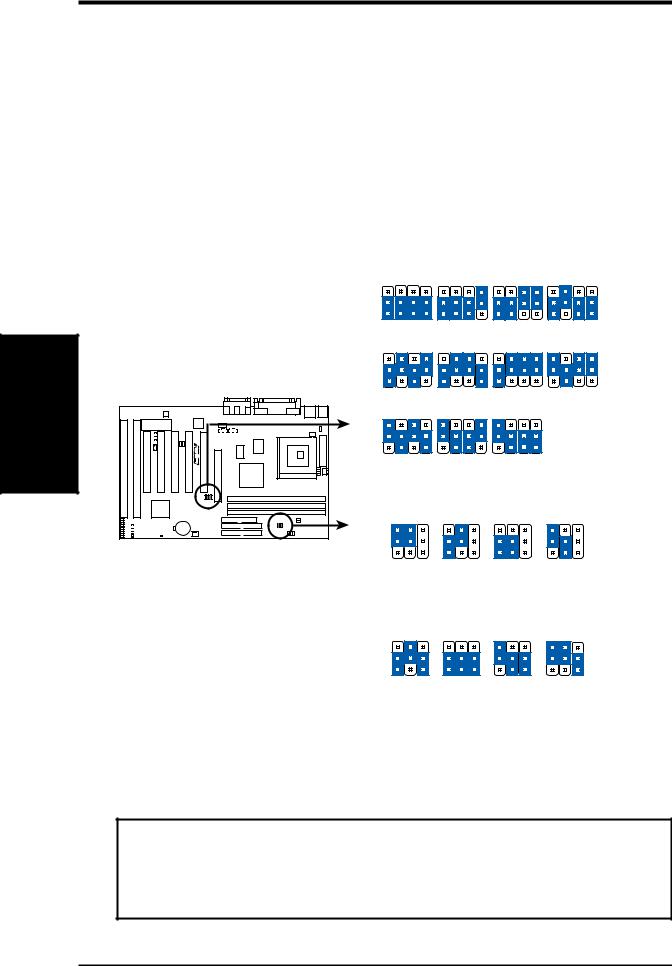
ALLATION INST .III
Jumpers
III.INSTALLATION
5.CPU External (BUS) Frequency Selection (FS3, FS2, FS1, FS0)
These jumpers tell the clock generator what frequency to send to the CPU, chipset, and AGP. These allow the selection of the CPU’s External frequency (or BUS Clock). The BUS Clock times the BUS Ratio equals the CPU's Internal frequency (the advertised CPU speed).
6.CPU to BUS Frequency Multiple (BF0, BF1, BF2)
These jumpers set the frequency ratio between the Internal frequency of the CPU and the External frequency (called the BUS Clock) within the CPU. These must be set in conjunction with the jumpers for CPU External (BUS) Frequency Selection.
FS3 FS2 FS1 FS0 |
FS3 FS2 FS1 FS0 |
FS3 FS2 FS1 FS0 |
FS3 FS2 FS1 FS0 |
1 |
|
|
|
|
2 |
|
|
|
|
3 |
|
|
|
|
CPU → |
60MHz |
66.8MHz |
75MHz |
75MHz |
AGP → |
60MHz |
66.8MHz |
75MHz |
60MHz |
PCI → |
30MHz |
33.4MHz |
37.5MHz |
30MHz |
1 |
2 |
3 |
|
|
|
|
CPU → |
83.3MHz |
95MHz |
100MHz |
105MHz |
AGP → |
66.6MHz |
63.3MHz |
66.6MHz |
70MHz |
PCI → |
33.3MHz |
31.6MHz |
33.3MHz |
35MHz |
1 |
|
|
2 |
|
|
3 |
|
|
CPU → 110MHz |
115MHz |
120MHz |
AGP → 73MHz |
77.6MHz |
80MHz |
PCI → 36.6MHz |
38.3MHz |
40MHz |
CPU External Clock (BUS) Frequency Selection
BF0 BF1 BF2 |
BF0 BF1 BF2 |
BF0 BF1 BF2 |
BF0 BF1 BF2 |
|
1 |
P5A |
2 |
3 |
Match the Mult. (Multiple) column of the table on the opposite page to these CPU types:
CPU A: AMD-K6-III,AMD-K6-2/400&faster
CPU B: AMD-K6-2/380&slower, AMD-K6
CPU C: Intel Pentium P54C, AMD-K5
CPU D: Intel Pentium P55C, IBM/Cyrix
6x86MX, IBM/Cyrix M II
CPU E: IBM/Cyrix 6x86, IBM/Cyrix 6x86L
CPU F: IDT WinChip 2™
CPU A →3.5x(7/2) |
6.0x(6/1) |
2.5x(5/2) |
3.0x(3/1) |
CPU B →3.5x(7/2) |
2.0x(2/1) |
2.5x(5/2) |
3.0x(3/1) |
CPU C →1.5x(3/2) |
2.0x(2/1) |
2.5x(5/2) |
3.0x(3/1) |
CPU D →3.5x(7/2) |
2.0x(2/1) |
2.5x(5/2) |
3.0x(3/1) |
CPU E →3.0x(3/1) |
2.0x(2/1) |
1.0x(1/1) |
— |
CPU F →3.5x(7/2) |
3.33x(10/3) |
2.5x(5/2) |
3.0x(3/1) |
BF0 BF1 BF2 |
BF0 BF1 BF2 |
BF0 BF1 BF2 |
BF0 BF1 BF2 |
1 |
2 |
3 |
CPU A →4.0x(4/1) |
4.5x(9/2) |
5.0x(5/1) |
5.5x(11/2) |
|
CPU B → |
4.0x(4/1) |
4.5x(9/2) |
5.0x(5/1) |
5.5x(11/2) |
CPU C → |
— |
— |
— |
— |
CPU D → |
— |
— |
— |
— |
CPU E → |
— |
— |
— |
— |
CPU F → |
4.0x(4/1) |
4.5x(9/2) |
2.33x(7/3) |
2.66x(8/3) |
CPU : BUS Frequency Multiple
WARNING! Frequencies above 100MHz exceed the specifications for the onboard chipset and are not guaranteed to be stable. The table on the following page is for general reference purposes only. Always refer to the instructions included with your CPU when possible.
16 |
ASUS P5A User’s Manual |

III. INSTALLATION
Set the jumpers by the Internal speed of your CPU as follows:
|
|
|
|
|
|
|
|
|
|
|
|
|
(BUS Freq.) |
(Freq. Mult.) |
|
|
|
|
|
|
|||
CPU Model |
Freq. |
Mult. BUS F. FS3 FS2 FS1 FS0 |
BF0 BF1 BF2 |
||||
AMD-K6-III/450 |
450MHz |
AMD-K6-III/400 |
400MHz |
AMD-K6-2/475 |
475MHz |
AMD-K6-2/450 |
450MHz |
AMD-K6-2/400 |
400MHz |
AMD-K6-2/380 |
380MHz |
AMD-K6-2/366 |
366MHz |
AMD-K6-2/350 |
350MHz |
AMD-K6-2/333 |
333MHz |
AMD-K6-2/300 |
300MHz |
AMD-K6-2/266 |
266MHz |
AMD-K6/300 |
300MHz |
AMD-K6/266 |
266MHz |
AMD-K6/233 |
233MHz |
AMD-K6/200 |
200MHz |
AMD-K6/166 |
166MHz |
AMD-K5/133 |
100MHz |
AMD-K5/120 |
90MHz |
AMD-K5/100 |
100MHz |
AMD-K5/90 |
90MHz |
Intel Pentium P54C |
166MHz |
Intel Pentium P54C |
150MHz |
Intel Pentium P54C |
133MHz |
Intel Pentium P54C |
120MHz |
Intel Pentium P54C |
100MHz |
Intel Pentium P54C |
90MHz |
Intel Pentium P55C |
233MHz |
Intel Pentium P55C |
200MHz |
Intel Pentium P55C |
166MHz |
IBM/Cyrix M II-PR333 |
333MHz |
IBM/Cyrix M II-PR300 |
300MHz |
IBM/Cyrix M II-PR300 |
300MHz |
IBM/Cyrix 6x86MX-PR233200MHz
IBM/Cyrix 6x86MX-PR200166MHz
IBM/Cyrix 6x86MX-PR166150MHz
*IBM/Cyrix 6x86-PR166+ 133MHz *IBM/Cyrix 6x86L-PR166+133MHz
A-4.5x 100MHz
A-4.0x 100MHz
A-5.0x 95MHz A-4.5x 100MHz A-4.0x 100MHz
B-4.0x 95MHz B-5.5x 66MHz B-3.5x 100MHz B-3.5x 95MHz B-3.0x 100MHz B-4.0x 66MHz
B-4.5x 66MHz B-4.0x 66MHz B-3.5x 66MHz B-3.0x 66MHz B-2.5x 66MHz
C-1.5x 66MHz C-1.5x 60MHz C-1.5x 66MHz C-1.5x 60MHz
C-2.5x 66MHz C-2.5x 60MHz C-2.0x 66MHz C-2.0x 60MHz C-1.5x 66MHz C-1.5x 60MHz
D-3.5x 66MHz D-3.0x 66MHz D-2.5x 66MHz
D-3.0x 83MHz D-3.0x 75MHz D-3.5x 66MHz
D-3.0x 66MHz D-2.5x 66MHz D-2.5x 60MHz
E-2.0x 66MHz E-2.0x 66MHz
[2-3] [1-2] [1-2] [1-2] [2-3] [1-2] [1-2] [1-2]
[2-3] [1-2] [1-2] [2-3] [2-3] [1-2] [1-2] [1-2] [2-3] [1-2] [1-2] [1-2]
[2-3] [1-2] [1-2] [2-3] [2-3] [2-3] [2-3] [1-2] [2-3] [1-2] [1-2] [1-2] [2-3] [1-2] [1-2] [2-3] [2-3] [1-2] [1-2] [1-2] [2-3] [2-3] [2-3] [1-2]
[2-3] [2-3] [2-3] [1-2] [2-3] [2-3] [2-3] [1-2] [2-3] [2-3] [2-3] [1-2] [2-3] [2-3] [2-3] [1-2] [2-3] [2-3] [2-3] [1-2]
[2-3] [2-3] [2-3] [1-2] [2-3] [2-3] [2-3] [2-3] [2-3] [2-3] [2-3] [1-2] [2-3] [2-3] [2-3] [2-3]
[2-3] [2-3] [2-3] [1-2] [2-3] [2-3] [2-3] [2-3] [2-3] [2-3] [2-3] [1-2] [2-3] [2-3] [2-3] [2-3] [2-3] [2-3] [2-3] [1-2] [2-3] [2-3] [2-3] [2-3]
[2-3] [2-3] [2-3] [1-2] [2-3] [2-3] [2-3] [1-2] [2-3] [2-3] [2-3] [1-2]
[2-3] [1-2] [2-3] [1-2] [2-3] [2-3] [1-2] [1-2] [2-3] [2-3] [2-3] [1-2]
[2-3] [2-3] [2-3] [1-2] [2-3] [2-3] [2-3] [1-2] [2-3] [2-3] [2-3] [2-3]
[2-3] [2-3] [2-3] [1-2] [2-3] [2-3] [2-3] [1-2]
[2-3] [2-3] [2-3] [2-3] [1-2] [2-3]
[1-2] [2-3] [2-3] [2-3] [2-3] [2-3] [2-3] [1-2] [2-3]
[2-3] [1-2] [2-3] [1-2] [1-2] [2-3]
[1-2] [1-2] [---- |
] |
[1-2] [1-2] [---- |
] |
[1-2] [2-3] [---- |
] |
[2-3] [1-2] [2-3]
[2-3] [2-3] [2-3] [2-3] [1-2] [2-3]
[1-2] [1-2] [ |
----] |
[1-2] [2-3] [---- |
] |
[2-3] [2-3] [---- |
] |
[1-2] [1-2] [---- |
] |
[1-2] [1-2] [---- |
] |
[1-2] [1-2] [---- |
] |
[1-2] [1-2] [---- |
] |
[2-3] [2-3] [---- |
] |
[2-3] [2-3] [---- |
] |
[2-3] [1-2] [---- |
] |
[2-3] [1-2] [---- |
] |
[1-2] [1-2] [---- |
] |
[1-2] [1-2] [---- |
] |
[1-2] [1-2] [---- |
] |
[1-2] [2-3] [---- |
] |
[2-3] [2-3] [---- |
] |
[1-2] [2-3] [---- |
] |
[1-2] [2-3] [---- |
] |
[1-2] [1-2] [---- |
] |
[1-2] [2-3] [---- |
] |
[2-3] [2-3] [---- |
] |
[2-3] [2-3] [---- |
] |
[2-3] [1-2] [---- |
] |
[2-3] [1-2] [---- |
] |
IDT WinChip 2™ |
240MHz F-4.0x 60MHz [2-3] [2-3] [2-3] [2-3] [2-3] [1-2] [2-3] |
*The only IBM or Cyrix 6x86(L) (or M I) that is supported on this motherboard is revision 2.7 or later (see next page).
NOTE: For updated processor settings, visit the ASUS web site (see ASUS CONTACT INFORMATION for URLs).
INST ALLATION |
Jumpers |
III. |
|
|
|
ASUS P5A User’s Manual |
17 |
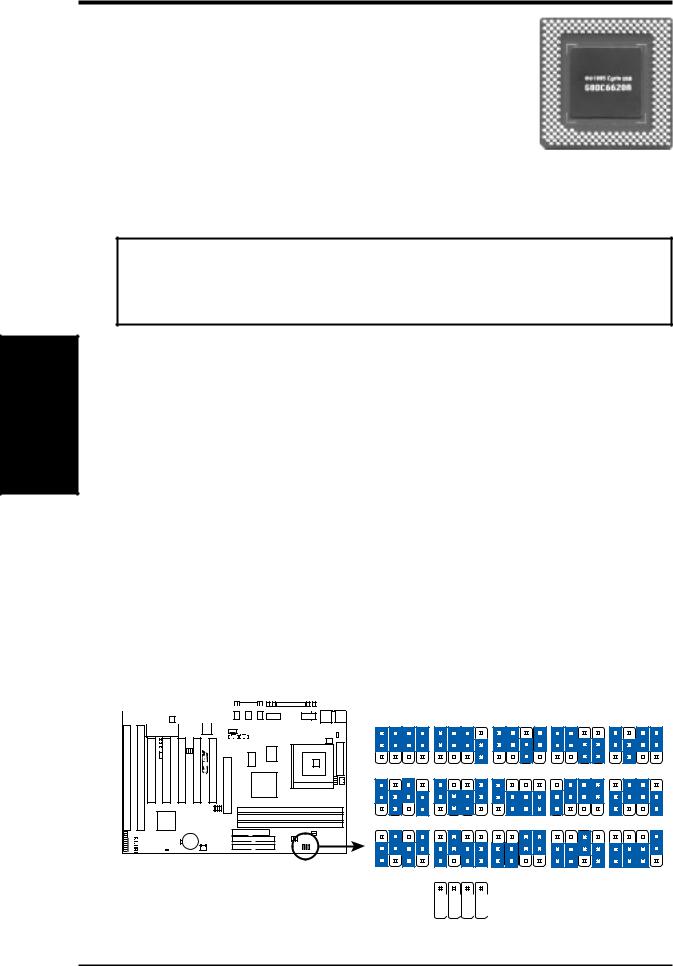
ALLATION INST .III
Jumpers
III. INSTALLATION
Compatible Cyrix CPU Identification
The only Cyrix 6x86-PR166+ CPU that is supported on this motherboard must be Revision 2.7 or later. Look on the underside of the CPU for the serial number. The number should read G8DC6620A or later.
7.Voltage Regulator Output Selection (VID0, 1, 2, 3)
These jumpers set the Core voltage supplied to the CPU. Switching regulators allow some jumper settings to be the same for two voltages of different power planes.
WARNING! Because CPU designs change rapidly, the table below is only intended as a simple guideline and thus may not be true for your CPU. Always refer to the CPU documentation for your CPU’s voltage and then set the appropriate VID jumpers according to the illustration below.
|
Manufacturer |
CPU Type |
Single Plane |
Dual Plane |
VID3 |
VID2 |
VID1 |
VID0 |
||||||||||||||||||||
|
AMD (.25micron) |
K6-III/400,450 |
---- |
2.4V(Dual) |
[1-2] |
|
[2-3] |
[1-2] |
[1-2] |
|||||||||||||||||||
|
|
|
|
|
|
|
|
|
K6-2/450,475 |
|
|
|
|
|
|
|
|
|||||||||||
|
|
|
|
|
|
|
|
|
|
|||||||||||||||||||
|
AMD (.25micron) |
K6-2/266,300,333 |
---- |
2.2V(Dual) |
[1-2] |
|
[1-2] |
[2-3] |
[1-2] |
|||||||||||||||||||
|
|
|
|
|
|
|
|
|
350,366,380,400 |
|
|
|
|
|
|
|
|
|||||||||||
|
|
|
|
|
|
|
|
|
K6/233,266,300 |
|
|
|
|
|
|
|
|
|||||||||||
|
|
|
|
|
|
|
|
|
|
|||||||||||||||||||
|
AMD |
K5 |
3.5V(VRE) |
---- |
[2-3] |
|
[2-3] |
[2-3] |
[2-3] |
|||||||||||||||||||
|
IBM/Cyrix |
6x86 |
3.5V(VRE) |
---- |
[2-3] |
|
[2-3] |
[2-3] |
[2-3] |
|||||||||||||||||||
|
Intel |
P54C/P54CS |
3.5V(VRE) |
---- |
[2-3] |
|
[2-3] |
[2-3] |
[2-3] |
|||||||||||||||||||
|
|
|
|
|
|
|
|
|
|
|||||||||||||||||||
|
AMD |
K5 |
3.4V(STD) |
---- |
[2-3] |
|
[2-3] |
[2-3] |
[1-2] |
|||||||||||||||||||
|
Intel |
P54C/P54CS |
3.4V(STD) |
--- |
[2-3] |
|
[2-3] |
[2-3] |
[1-2] |
|||||||||||||||||||
|
|
|
|
|
|
|
|
|
|
|||||||||||||||||||
|
AMD (.35micron) |
K6-PR233 |
---- |
3.2V(Dual) |
[2-3] |
|
[2-3] |
[1-2] |
[1-2] |
|||||||||||||||||||
|
|
|
|
|
|
|
|
|
|
|||||||||||||||||||
|
AMD (.35micron) |
K6-166,200 |
---- |
2.9V(Dual) |
[2-3] |
|
[1-2] |
[1-2] |
[2-3] |
|||||||||||||||||||
|
IBM/Cyrix |
6x86MX |
---- |
2.9V(Dual) |
[2-3] |
|
[1-2] |
[1-2] |
[2-3] |
|||||||||||||||||||
|
|
|
|
|
|
|
|
|
|
|||||||||||||||||||
|
Intel |
P55C-MMX |
---- |
2.8V(Dual) |
[2-3] |
|
[1-2] |
[1-2] |
[1-2] |
|||||||||||||||||||
|
|
|
|
|
|
|
|
|
|
|
|
|
|
|
|
|
|
|
|
|
|
|
|
|
|
|
|
|
|
|
|
|
|
|
|
|
|
|
|
|
|
|
|
|
|
|
|
|
|
|
VID3 VID2 VID1 VID0 |
VID3 VID2 VID1 VID0 VID3 VID2 |
VID1 VID0 |
VID3 VID2 VID1 |
VID0 VID3 VID2 |
VID1 VID0 |
|
1 |
|
|
|
|
2 |
|
|
|
|
3 |
|
2.2Volts |
2.3Volts |
|
2.0Volts |
2.1Volts |
2.4Volts |
1 |
|
|
|
|
2 |
|
|
|
|
3 |
|
2.7Volts |
2.8Volts |
|
2.5Volts |
2.6Volts |
2.9Volts |
1 |
|
|
|
|
2 |
|
|
|
|
3 |
|
|
|
|
3.0Volts |
3.1Volts |
3.2Volts |
3.3Volts |
3.4Volts |
P5A CPU Core Voltage Selection |
1 |
|
|
2 |
|
|
3 |
|
3.5Volts
18 |
ASUS P5A User’s Manual |

III.INSTALLATION
2.System Memory (DIMM)
This motherboard uses only Dual Inline Memory Modules (DIMMs). Sockets are available for 3.3Volt (power level) unbuffered Synchronous Dynamic Random Access Memory (SDRAM) of either 8, 16, 32, 64, 128MB, or 256MB to form a memory size between 8MB and 768MB. One side (with memory chips) of the DIMM takes up one row on the motherboard.
To utilize the chipset’s Error Checking and Correction (ECC) feature, you must use a DIMM module with 9 chips per side (standard 8 chips/side + 1 ECC chip) and make the proper settings through “Chipset Features Setup” in BIOS setup.
Memory speed setup is recommended through SDRAM Configuration under “Chipset Features Setup” in BIOS setup.
IMPORTANT (see General DIMM Notes below)
• To make using bus speeds ≥95MHz possible, SDRAMs used must be compatible with the current Intel PC100 SDRAM specification..
Install memory in any combination as follows:
DIMM Location |
168-pin DIMM |
|
Total Memory |
Socket 1 (Rows 0&1) |
SDRAM 8, 16, 32, 64, 128, 256MB |
x1 |
|
|
|
|
|
Socket 2 (Rows 2&3) |
SDRAM 8, 16, 32, 64, 128, 256MB |
x1 |
|
|
|
|
|
Socket 3 (Rows 4&5) |
SDRAM 8, 16, 32, 64, 128, 256MB |
x1 |
|
|
|
|
|
|
Total System Memory (Max 768MB) |
= |
|
|
|
|
|
NOTES
•At the time this User’s Manual was written, 256MB DIMMs are either available as registered memory or 128Mbit DIMMs.
•DIMMs that have more than 18 chips are not supported on this motherboard.
•For the system CPU bus to operate ≥95MHz, use only PC100-compliant DIMMs.
When this motherboard operates at ≥95MHz, most system will not even boot if noncompliant modules are used because of the strict timing issues involved under these speeds. If your DIMMs are not PC100-compliant, set the CPU bus frequency to 66MHz for system stability.
•ASUS motherboards support SPD (Serial Presence Detect) DIMMs. This is the memory of choice for best performance vs. stability.
•SDRAM chips are generally thinner with higher pin density than EDO (Extended Data Output) chips.
•BIOS shows SDRAM memory on bootup screen.
•Single-sided DIMMs come in 16, 32, 64,128MB; double-sided come in 32, 64, 128, 256MB.
System Memory
III. INST ALLATION
ASUS P5A User’s Manual |
19 |
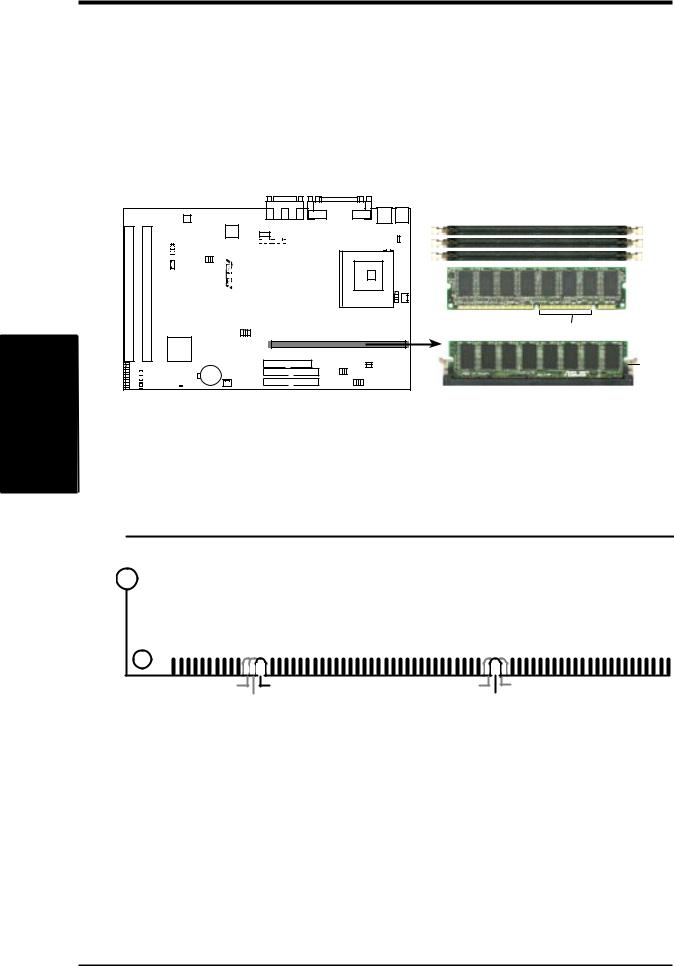
III. INSTALLATION
DIMM Memory Installation Procedures:
Insert the module(s) as shown. Because the number of pins are different on either side of the breaks, the module will only fit in the orientation as shown. DRAM SIMM modules have the same pin contacts on both sides. SDRAM DIMMs have different pin contacts on each side and therefore have a higher pin density.
ALLATION INST .III
Memory System
|
|
|
|
|
|
|
|
|
|
|
|
|
|
|
|
|
|
|
|
|
|
|
|
|
|
|
|
|
|
|
|
|
|
|
|
|
|
|
|
|
|
|
|
|
|
|
|
|
|
|
|
|
|
|
|
|
|
|
|
|
|
|
|
|
|
|
|
|
|
|
|
|
|
|
|
|
|
|
|
|
|
|
|
|
|
|
|
|
|
|
|
|
|
|
|
|
|
|
|
|
|
|
|
|
|
|
|
|
|
|
|
|
|
|
|
|
|
|
|
|
|
|
|
|
|
|
|
|
|
|
|
|
|
|
|
|
|
|
|
|
|
|
|
|
|
|
|
|
|
|
|
|
|
|
|
|
|
|
|
|
|
|
|
|
|
|
|
|
|
|
|
|
|
|
|
|
|
|
|
|
|
|
|
|
|
|
|
|
|
|
|
|
|
|
|
|
|
|
|
|
|
|
|
|
|
|
|
|
|
|
|
|
|
|
|
|
|
|
|
|
|
|
|
|
|
|
|
|
|
|
|
|
|
|
|
|
|
|
|
|
|
|
|
|
|
|
|
|
|
|
|
|
|
|
|
|
|
|
|
|
|
|
|
|
|
|
|
|
|
|
|
|
|
|
|
|
|
|
|
|
|
|
|
|
|
|
|
|
|
|
|
|
|
|
|
|
|
|
|
|
|
|
|
|
|
|
|
|
|
|
|
|
|
|
|
|
|
|
|
|
|
|
|
|
|
|
|
|
|
|
|
|
|
|
|
|
|
|
|
|
|
|
|
|
|
|
|
|
|
|
|
|
|
|
|
|
|
|
|
|
|
|
|
|
|
|
|
|
|
|
|
|
|
|
|
|
|
|
|
|
|
|
|
|
|
|
|
|
|
|
|
|
|
|
|
|
|
|
|
|
|
|
|
|
|
|
|
|
|
|
|
|
|
|
|
|
|
|
|
|
|
|
|
|
|
|
|
|
|
|
|
|
|
|
|
|
|
|
|
|
|
|
|
|
|
|
|
|
|
|
|
|
|
|
|
|
|
|
|
|
|
|
|
|
|
|
|
|
|
|
|
|
|
|
|
|
|
|
|
|
|
|
|
|
|
|
|
|
|
|
|
|
|
|
|
|
|
|
|
|
|
|
|
|
|
|
|
|
|
|
|
|
|
|
|
|
|
|
|
|
|
|
|
|
|
|
|
|
|
|
|
|
|
|
|
|
|
|
|
|
|
|
|
|
|
|
|
|
|
|
|
|
|
|
|
|
|
|
|
|
|
|
|
|
|
|
|
|
|
|
|
|
|
|
|
|
|
|
|
|
|
|
|
|
|
|
|
|
|
|
|
|
|
|
|
|
|
|
|
|
|
|
|
|
|
|
|
|
|
|
|
|
|
|
|
|
|
|
|
|
|
|
|
|
|
|
|
|
|
|
|
|
|
|
|
|
|
|
|
|
|
|
|
|
|
|
|
|
|
|
|
|
|
|
|
|
|
|
|
|
|
|
|
|
|
|
|
|
|
|
|
|
|
|
|
|
|
|
|
|
|
|
|
|
|
|
|
|
|
|
|
|
|
|
|
|
|
|
|
|
|
|
|
|
|
|
|
|
|
|
|
|
|
|
|
|
|
|
|
|
|
|
|
|
|
|
|
|
|
|
|
|
|
|
|
|
|
|
|
|
|
|
|
|
|
|
|
|
|
|
|
|
|
|
|
|
|
|
|
|
|
|
|
|
|
|
|
|
|
|
|
|
|
|
|
|
|
|
|
|
|
|
|
|
|
|
|
|
|
|
|
|
|
|
|
|
|
|
|
|
|
|
|
|
|
|
|
|
|
|
|
|
|
|
|
|
|
|
|
|
|
|
|
|
|
|
|
|
88 Pins |
60 Pins 20 Pins |
|||||||||
|
|
|
|
|
|
|
|
|
|
|
|
|
|
|
|
|
|
|
|
|
|
|
|
|
|
|
|
|
|
|
|
|
|
|
|
|
|
|
|
|
|
|
|
|
|||||||||||
|
|
|
|
|
|
|
|
|
|
|
|
|
|
|
|
|
|
|
|
|
|
|
|
|
|
|
|
|
|
|
|
|
|
|
|
|
|
|
|
|
|
|
|
|
|
|
|
|
|
|
|
|
|
|
|
|
|
|
|
|
|
|
|
|
|
|
|
|
|
|
|
|
|
|
|
|
|
|
|
|
|
|
|
|
|
|
|
|
|
|
|
|
|
|
|
|
|
|
|
|
|
|
|
|
|
|
|
|
|
|
|
|
|
|
|
|
|
|
|
|
|
|
|
|
|
|
|
|
|
|
|
|
|
|
|
|
|
|
|
|
|
|
|
|
|
|
|
|
|
|
|
|
|
|
|
|
|
|
|
|
|
|
|
|
|
|
|
Lock
P5A 168 Pin DIMM Memory Sockets
The DIMMs must be 3.3Volt unbuffered SDRAMs. To determine the DIMM type, check the notches on the DIMMs (see figure below).
168-Pin DIMM Notch Key Definitions (3.3V)
|
|
|
|
|
|
|
|
|
|
|
|
|
|
|
|
|
|
|
|
|
|
|
|
|
|
|
|
|
|
DRAM Key Position |
Voltage Key Position |
|||
RFU |
Unbuffered |
5.0V |
Reserved |
Buffered |
|
3.3V |
|
The notches on the DIMM will shift between left, center, or right to identify the type and also to prevent the wrong type from being inserted into the DIMM slot on the motherboard. You must tell your retailer the correct DIMM type before purchasing. This motherboard supports four clock signals.
20 |
ASUS P5A User’s Manual |

III.INSTALLATION
3.Central Processing Unit (CPU)
The motherboard provides a 321-pin ZIF Socket 7 that is backwards compatible with ZIF Socket 5 processors. The CPU that came with the motherboard should have a fan attached to it to prevent overheating. If this is not the case then purchase a fan before you turn on your system.
WARNING! Without a fan circulating air on the CPU, the CPU can overheat and cause damage to both the CPU and the motherboard.
To install a CPU, first turn off your system and remove its cover. Locate the ZIF socket and open it by first pulling the lever sideways away from the socket then upwards to a 90-degree right angle. Insert the CPU with the correct orientation as shown. Use the notched corner of the CPU with the white dot as your guide. The white dot should point toward the end of the lever. Notice that there is a blank area where one hole is missing from that corner of the square array of pin holes and a “1” printed on the motherboard next to that corner. Because the CPU has a corner pin for three of the four corners, the CPU will only fit in the one orientation as shown. The picture is for reference only; you should have a CPU fan that will cover the face of the CPU. With the added weight of the CPU fan, no force is required to insert the CPU. Once completely inserted, hold down on the fan and close the socket’s lever.
IMPORTANT: You must set jumpers for “CPU to BUS Frequency Ratio” and jumpers for “BUS Frequency Selection” depending on the CPU that you install.
CAUTION! Be careful not to scrape the motherboard when mounting a clampstyle processor fan or else damage may occur to the motherboard.
Blank
1
Lever 
Lock 
P5A ZIF Socket 7
INST ALLATION |
CPU |
III. |
|
ASUS P5A User’s Manual |
21 |

(This page was intentionally left blank.)
22 |
ASUS P5A User’s Manual |
